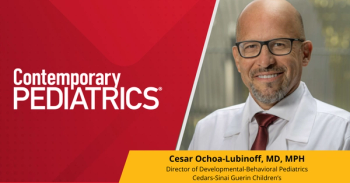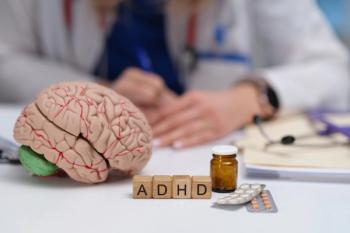
- Consultant for Pediatricians Vol 10 No 3
- Volume 10
- Issue 3
The Uncontrollable Child: Family and Educational Interventions
It is estimated that about 20% of children and adolescents meet criteria for a mental health disorder, and a high percentage of these youths are impaired by disruptive behavior problems.
It is estimated that about 20% of children and adolescents meet criteria for a mental health disorder, and a high percentage of these youths are impaired by disruptive behavior problems. Children with disruptive behavior problems include those who meet criteria for attention-deficit/hyperactivity disorder (ADHD), oppositional defiant disorder (ODD), or conduct disorder (CD), as well as those who have impairments related to disruptive behavior who may not meet formal criteria for one of these diagnoses. While medication is generally an effective treatment for children with disruptive behavior problems, in particular ADHD,1 some form of nonpharmacological treatment is often necessary to help these children function normally in academic and social settings.
A wide range of nonpharmacological interventions have been shown to be effective in managing family and school impairments associated with disruptive behavior problems. Psychosocial interventions can be family-based or school-based. (For a description of school-based interventions, see the review by Power and colleagues.2) In this article, we summarize empirically supported family-based psychosocial treatments for children aged 5 to 12 years with disruptive behavior problems, including ADHD, ODD, and CD. We emphasize family-based interventions that can have an effect on children's functioning in both family and school settings and that can be delivered within the pediatric primary care setting or in connection with a mental health practice. Because these interventions require slight adjustments depending on developmental stage and economic background of the child,3 we also review adaptations for working with preschool children, adolescents, and families from underserved populations.
Unfortunately, well below 50% of children who need mental health care actually receive services. Children and adolescents who are least likely to receive services are those belonging to racial and ethnic minority groups, who are disproportionately represented among the poor and uninsured in this nation.4 Barriers to mental health care can be divided into access problems (cost of services, availability of care) and family beliefs (lack of trust in health care system or providers, unfavorable views about evidence-based treatments) that may preclude engagement in services.5
Pediatric primary care practices and schools are major venues for the delivery of mental health services to children and adolescents. Providing mental health services in these settings can improve access and help overcome some of the barriers to care. Nonetheless, when addressing the needs of youths with disruptive behavior problems, pediatric providers face substantial challenges, including limited time, reimbursement issues, and lack of mental health care training.6 Models of collaborative practice with mental health providers have been developed to address these limitations and are discussed in this article in an effort to help pediatricians implement evidence-based interventions.
EVIDENCE-BASED PSYCHOSOCIAL TREATMENT
Family-based behavioral interventions. More than 4 decades of research indicate that family-based psychosocial interventions are effective treatments for children with ADHD, ODD, or CD.7-9 These interventions are guided primarily by attachment theory, social learning principles, and cognitive-behavioral theories of change that involve both altering antecedents and consequences of behavior and building cognitive skills. Often referred to as “parent training” programs, effective family-based interventions are typically parent-mediated in that the bulk of therapeutic work is conducted face-to-face with parents in an effort to modify the home environment and patterns of parent-child interaction.
Parent training protocols involve a number of common elements in that they:
• Educate parents about their child's condition and how symptoms lead to concerns at home, at school, and with peers.
• Teach parents ways to establish or maintain a warm and positive relationship that facilitates attempts to regulate their children's behavior.
• Help parents implement behavior management skills at home. Specific skills include the use of effective commands and positive reinforcement/praise in response to appropriate behavior, the development of a contingency management system (ie, token economy, point system), and the use of strategic punishment.
The goal of parent training protocols that address childhood ADHD, ODD, antisocial behavior, and other externalizing problems is to improve relationships among family members and teach effective behavior management strategies. Depending on the nature of the problem, parent training programs can be delivered via group treatment with parents and children, individual treatment with parents only, or individualized family treatment. Parent training programs typically last between 10 and 20 weekly or biweekly sessions, with follow-up “booster sessions” to track progress and problem-solve future challenges.
Techniques used to reach treatment goals include didactic instruction, skill-building exercises, role-playing, coaching, and homework assignments. Homework assignments involve the implementation and monitoring of a new strategy between sessions. A number of excellent Web sites (eg,
Educational interventions involving the family. Family involvement in education has been shown to improve school performance of children with disruptive behavior problems. Table 1 provides an example of a 12-session family-school intervention program. An important component of successful family involvement is the establishment of a partnership between parent and teacher.13 Conjoint behavioral consultation is an evidenced-based method of building such a partnership that can be integrated into traditional parent training programs.14 A core feature of this method is the recognition that the parent-teacher partnership can improve the school performance of children with disruptive behavior problems.
Daily report card. One way children with a wide range of disruptive behavior problems can benefit from conjoint behavioral consultation is through the use of a daily report card. This typically includes 3 to 5 target behaviors or goals that specify clear behavioral expectations (eg, raises hand to speak, completes work quietly). Teachers then rate the child's achievement on these goals throughout the school day. Finally, parents provide positive reinforcement contingent on performance on the daily report card. Use of a daily report card has been found to decrease disruptive behaviors and associated impairments among children with ADHD in special education.15 A school-based intervention program that included the use of daily report cards also led to improvement in parent and teacher ratings of attention, social functioning, and organizational skills.16
Homework intervention. Homework can be quite challenging for many children and families, particularly if the child exhibits defiant or inattentive behavior. Children with attention problems often forget materials necessary to complete assignments, do not record assignments correctly, procrastinate during homework sessions, and make careless mistakes on assignments.17,18 Behavioral interventions have been shown repeatedly to be effective in improving homework performance.19,20
If families present with concerns about homework completion, pediatricians can help by providing suggestions about:
• Goal setting (ie, breaking assignments into manageable units and setting time limits for completion).
• Positive reinforcement (ie, providing tokens or rewards contingent on timely homework completion or sustained effort during the homework session).
• Environmental modifications (ie, identifying a consistent, quiet location for homework sessions and ensuring that necessary supplies are available).
Homework is also a mechanism for promoting ongoing home-school communication through daily assignments.21 For children with attention problems or disruptive behavior, communication between home and school often is strained.22 Health care providers can encourage families to discuss homework issues directly with teachers (eg, amount of work assigned, difficulty level of assignments). For cases in which the home-school relationship appears to be particularly strained, physicians might recommend that the family work with a consultant (eg, school psychologist, guidance counselor) to develop homework strategies while supporting a collaborative home-school relationship.
Combined therapy. Psychosocial interventions are often used in conjunction with pharmacological treatments, in particular with the stimulants and atomoxetine.23 Parents and teachers generally view integrated treatments more favorably than separate treatments.24 Results of the Multimodal Treatment Study of Children With ADHD revealed a higher proportion of normalization in children with ADHD or ODD who received combined treatment than in those who received either behavior therapy or medication alone.25 The Preschool ADHD Treatment Study found that although stimulant medication is effective in addressing functional impairments in preschool-aged children with attention and behavior problems, similar to findings in older children, additional interventions (eg, behavioral intervention) may also be helpful.26 However, combined approaches are often difficult to coordinate and typically require clear and consistent communication among providers and across systems (home, school, health care).
Other interventions. Interventions for disruptive behavior not discussed in this article include those that are intended for implementation in alternative settings or require a level of care and resources not typically available in primary care. Examples of these are school-based approaches to improve attention, behavior, and social behavior2,27; comprehensive summer treatment programs that provide behavioral parent training, social activities, and academic instruction in a camp-like setting28; and multisystemic therapy to decrease the risk of out-of-home placement for children who exhibit a persistent pattern of serious antisocial behavior.29
ADAPTATIONS FOR DIFFERENT AGE-GROUPS AND THE UNDERSERVED
Working with preschool-aged children. Although the principles underlying psychosocial treatment for preschool-aged children with disruptive behavior problems are the same as those for older children, strategies need to be adjusted to address developmental differences. For instance, when implementing a token reinforcement system with young children, remind parents that reinforcement must be delivered more frequently than with older children. Reinforcement options may need to be altered more often in order to maintain the novelty of the system. Although preschoolers do not have homework, parents can establish a “curriculum of the home” through consistently communicating the value of education and creating a home environment that supports learning (ie, by limiting TV and video game time and providing educational games and materials).30,31
Working with adolescents. Disruptive behavior problems often persist or emerge in the adolescent years. In adolescence, externalizing problems are often associated with more serious impairments. Perhaps the most important adaptation when working with adolescents with disruptive behavior disorders is the need for greater inclusion of the adolescent in many aspects of treatment. Given adolescents' desire for greater autonomy from parents, traditional parent-mediated interventions are likely to generate significant conflict without sufficient engagement from the adolescent. Adherence and outcomes are likely to be optimal when an adolescent acknowledges a concern and is a willing participant in therapy. Teens may be increasingly involved in the development of token economies or the implementation of homework strategies.32 Individual therapy to address comorbid internalizing problems, additional school supports, and the involvement of peers when establishing antecedent strategies of a contingency management system may also be needed.
Working with underserved populations. Families in inner-city urban or isolated rural environments may encounter more difficulties in obtaining care than other families. Inner-city urban families face economic hardships, high levels of family unemployment, single-parent homes, and community violence at a higher rate than other families.33 All of these factors may have an impact on help-seeking behavior. Because of issues related to mistrust of the health care system,34 these families may be hesitant to seek help when a problem exists. By definition, isolated rural families must travel long distances to visit health care providers and may be uninsured or live below the poverty line.35,36 A recent study found that only 36% of rural children with an identifiable mental health disorder had received care in the preceding months.37
Eiraldi and colleagues38 proposed a model of help-seeking behavior that is specifically designed for underserved children with disruptive behavior disorders. The model highlights challenges and proposed solutions to promote help-seeking in each of 4 stages: problem recognition, decision to seek help, service selection, and use of service. One strategy to improve access is to offer mental health services in more trusted medical homes (ie, pediatric primary care center) or alongside health care providers or social workers who have an established relationship with the family. Regularly screening for behavior problems, educating parents and caregivers about the nature and treatment of behavioral health problems, and discussing parents' expectations of and attitudes about treatment can also address certain barriers to care. It may be helpful for primary care practices to designate a staff member to serve as a behavioral health liaison and consult with families who screen positive for behavior problems.
MODELS OF SERVICE DELIVERY
Table 2 lists 4 service delivery options that promote collaboration between pediatric providers and mental health professionals to address the behavioral health needs of children identified in pediatric practice.38-40 Strengths and limitations of each model are described. The approach that is best suited to a particular practice depends on the goals and preferences of pediatric providers, feasibility issues (space in the practice setting and administrative support for mental health services), and mental health resources in the community.
References:
REFERENCES:
1. Brown RT, Antonuccio DO, DuPaul GJ, et al. Childhood Mental Health Disorders: Evidence Base and Contextual Factors for Psychosocial, Psychopharmacological, and Combined Interventions. Washington, DC: American Psychological Association; 2008.
2. Power TJ, Tresco KE, Cassano MC. School-based interventions for students with attention-deficit/hyperactivity disorder. Curr Psychiatry Rep. 2009;11:407-414.
3. Mercugliano M, Power TJ, Blum NJ. The Clinician's Practical Guide to Attention-Deficit/Hyperactivity Disorder. Baltimore: Brookes Publishing; 1999.
4. US Department of Health and Human Services. Mental Health: Culture, Race, and Ethnicity-A Supplement to Mental Health: A Report of the Surgeon General. Rockville, MD: US Department of Health and Human Services, Substance Abuse and Mental Health Services Administration, Center for Mental Health Services; 2001.
5. Power TJ, Eiraldi RB, Clarke AT, et al. Improving mental health service utilization for children and adolescents. School Psychol Q. 2005;20:187-205.
6. Leslie LK, Stallone KA, Weckerly J, et al. Implementing ADHD guidelines in primary care: does one size fit all? J Health Care Poor Underserved. 2006;17:302-327.
7. Forgatch MS, Patterson GR. Parent management training-Oregon Model: an intervention for antisocial behavior in children and adolescents. In: Weisz JR, Kazdin AE, eds. Evidence-Based Psychotherapies for Children and Adolescents. 2nd ed. New York: Guilford Press; 2010:159-178.
8. Webster-Stratton C, Reid MJ. The Incredible Years Parents, Teachers, and Children Training Series: a multifaceted treatment approach for young children with conduct disorders. In: Weisz JR, Kazdin AE, eds. Evidence-Based Psychotherapies for Children and Adolescents. 2nd ed. New York: Guilford Press; 2010:194-210.
9. Zisser A, Eyberg SM: Treating oppositional behavior in children using parent-child interaction therapy. In: Weisz JR, Kazdin AE, eds. Evidence-Based Psychotherapies for Children and Adolescents. 2nd ed. New York: Guilford Press; 2010:179-193.
10. Barkley RA. Defiant Children: A Clinician's Manual for Assessment and Parent Training. 2nd ed. New York: Guilford Press; 1997.
11. Webster-Stratton C. The Incredible Years-A Trouble-Shooting Guide for Parents of Children Aged 3-8 Years. Seattle: Incredible Years Press; 2006.
12. Kazdin AE. Problem-solving skills training and parent management training for oppositional defiant disorder and conduct disorder. In: Weisz JR, Kazdin AE, eds. Evidence-Based Psychotherapies for Children and Adolescents. 2nd ed. New York: Guilford Press; 2010:211-226.
13. Power TJ, Mautone JA. Best practices in linking families and schools to educate children with attention problems. In: Thomas A, Grimes J, eds. Best Practices in School Psychology V. Bethesda, MD: National Association of School Psychologists; 2008:839-851.
14. Sheridan SM, Kratochwill TR. Conjoint Behavioral Consultation: Promoting Family-School Connections and Interventions. 2nd ed. New York: Springer; 2008.
15. Fabiano GA, Vujnovic RK, Pelham WE, et al. Enhancing the effectiveness of special education programming for children with attention deficit hyperactivity disorder using a daily report card. School Psychol Rev. In press.
16. Pfiffner LJ, Yee Mikami A, Huang-Pollock C,
et al. A randomized, controlled trial of integrated home-school behavioral treatment for ADHD,
predominantly inattentive type. J Am Acad Child Adolesc Psychiatry. 2007;46:1041-1050.
17. Langberg JM, Epstein JN, Urbanowicz C, et al. Efficacy of an organization skills intervention to
improve the academic functioning of students with attention-deficit/hyperactivity disorder. School Psychol Q. 2008;23:407-417.
18. Power TJ, Werba BE, Watkins MW, et al. Patterns of parent-reported homework problems among ADHD-referred and non-referred children. School Psychol Q. 2006;21:13-33.
19. Axelrod MI, Zhe EJ, Haugen KA, Klein JA. Self-management of on-task homework behavior: a promising strategy for adolescents with attention and behavior problems. School Psychol Rev. 2009; 38:325-333.
20. Langberg JM, Arnold LE, Flowers AM, et al. Parent-reported homework problems in the MTA study: evidence for sustained improvement with behavioral treatment. J Clin Child Adolesc Psychol. 2010;39:220-233.
21. Olympia DE, Sheridan SM, Jenson WR, Andrews D. Using student-managed interventions to increase homework completion and accuracy. J Appl Behav Anal. 1994;27:85-99.
22. Power TJ, Karustis JL, Habboushe DF. Homework Success for Children With ADHD: A Family-School Intervention Program. New York: Guilford Press; 2001.
23. Pliszka SR, Crismon ML, Hughes CW, et al; Texas Consensus Conference Panel on Pharmacotherapy of Childhood Attention Deficit Hyperactivity Disorder. The Texas Children's Medication Algorithm Project: revision of the algorithm for pharmacotherapy of attention-deficit/hyperactivity disorder. J Am Acad Child Adolesc Psychiatry. 2006;45:642-657.
24. Krain AL, Kendall PC, Power TJ. The role of treatment acceptability in the initiation of treatment for ADHD. J Atten Disord. 2005;9:425-434.
25. Swanson JM, Kraemer HC, Hinshaw SP, et al. Clinical relevance of the primary findings of the MTA: success rates based on severity of ADHD and ODD symptoms at the end of treatment. J Am Acad Child Adolesc Psychiatry. 2001;40:168-179.
26. Abikoff HB, Vitiello B, Riddle MA, et al. Methylphenidate effects on functional outcomes in the
Preschoolers with Attention-Deficit/Hyperactivity Disorder Treatment Study (PATS). J Child Adolesc Psychopharmacol. 2007;17:581-592.
27. DuPaul GJ, Stoner G. ADHD in the Schools: Assessment and Intervention Strategies. 2nd ed. New York: Guilford Press; 2003.
28. Pelham WE, Gnagy EM, Greiner AR, et al. Summer treatment programs for attention-deficit/hyperactivity disorder. In: Weisz JR, Kazdin AE, eds. Evidence-Based Psychotherapies for Children and Adolescents. 2nd ed. New York: Guilford Press; 2010:277-292.
29. Henggeler SW, Schoenwald SK, Borduin CM, et al. Multisystemic Therapy for Antisocial Behavior in Children and Adolescents. 2nd ed. New York: Guilford Press; 2009.
30. Walberg HJ. Families as partners in educational productivity. Phi Delta Kappan. 1984;65:397-400.
31. Christenson SL, Sheridan SM. Schools and Families: Creating Essential Connections for Learning. New York: Guilford Press; 2001.
32. Raggi VL, Chronis-Tuscano A, Fishbein H, Groomes A. Development of a brief, behavioral homework intervention for middle school students with attention-deficit/hyperactivity disorder. School Ment Health. 2009;1:61-77.
33. Johnson H. Vulnerable youth and the transition to adulthood: youth from distressed neighborhoods. ASPE Research Brief. Washington, DC: Office of Human Services Policy, US Department of Health and Human Services; 2009.
34. Suite DH, La Bril R, Primm A, Harrison-Ross P. Beyond misdiagnosis, misunderstanding and mistrust: relevance of the historical perspective in the medical and mental health treatment of people of color. J Natl Med Assoc. 2007;99:879-885.
35. Johnson ME, Brems C, Warner TD, Roberts LW. Rural-urban health care provider disparities in Alaska and New Mexico. Adm Policy Ment Health. 2006;33:504-507.
36. Coburn AF, McBride TD, Ziller EC. Patterns
of health insurance coverage among rural and urban children. Med Care Res Rev. 2002;59:272-292.
37. Angold A, Erkanli A, Farmer EM, et al. Psychiatric disorder, impairment, and service use in rural African American and white youth. Arch Gen Psychiatry. 2002;59:893-901.
38. Eiraldi RB, Mazzuca LB, Clarke AT, Power TJ. Service utilization among ethnic minority children with ADHD: a model of help-seeking behavior. Adm Policy Ment Health. 2006;33:607-622.
39. Connor DF, McLaughlin TJ, Jeffers-Terry M, et al. Targeted child psychiatric services: a new model of pediatric primary clinician-child psychiatry collaborative care. Clin Pediatr (Phila). 2006; 45:423-434.
40. Lavigne JV, Lebailly SA, Gouze KR, et al. Treating oppositional defiant disorder in primary care: a comparison of three models. J Pediatr Psychol. 2008;33:449-461.
41. Power TJ, Soffer SL, Clarke AT, Mautone JA. Multisystemic intervention for children with ADHD. Rep Emotional Behav Disord Youth. 2006;6:51-52.
Articles in this issue
almost 15 years ago
Newborn With Urinary Dysfunctionalmost 15 years ago
Car Seat Phobia: Where It May Stem From, How to Correct Italmost 15 years ago
Would you continue acne therapy for a teenage boy with severe scarring?almost 15 years ago
Infant With Persistent Fever and Fussinessalmost 15 years ago
Unexpected Finding in Young Girl After Arm Injuryalmost 15 years ago
Molluscum Contagiosum on the Face of a 4-Year-Old Boyalmost 15 years ago
Tinea Facieialmost 15 years ago
Baby Boy Cries With One Eye Openalmost 15 years ago
Aplasia Cutis Congenita With Associated Fetus PapyraceusNewsletter
Access practical, evidence-based guidance to support better care for our youngest patients. Join our email list for the latest clinical updates.








